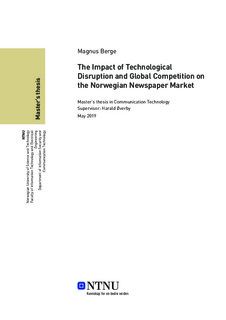| dc.description.abstract | Det er få teknologiske oppfinnelser som har påvirka så mange bransjer som det internett har. Internett har vært årsaka til mange endringer i mange markeder. Noen av disse endringene er blant anna enklere og raskere kommunikasjon, introduksjon av nye konkurrenter til markeder som tidligere har vært utilgjengelige, samt en reduksjon i kostnader knytta til distribusjon av innhold. Det norske avismarkedet er blant markedene som har blitt påvirka av introdusjonen av internett. De har hovedsakelig opplevd endringer når det kommer til nye konkurrenter, som Google og Facebook. I løpet av få år tok Google og Facebook en betydelig del av annonsemarkedet til de norske avisbedriftene.
Denne oppgava bidrar til det tidligere arbeidet som er gjort rundt de endringene dagens teknologiske trender har påført det norske mediemarkedet. Bidraget er ei undersøking av åssen avisselskapa har tilpassa seg endringene, hvilke endringer de har gjort, og hvilke endringer de holder på å gjennomføre. For å gjøre dette har det blitt brukt en metode som kombinerer litteraturgjennomgang og intervjuer. Ved å lese denne oppgava vil du se bakgrunnen og de relevante verka for oppgava. I tillegg vil du få ei forklaring og presentasjon av metoden som er brukt. Til slutt vil resultatene bli presentert og diskutert, før de endelige konklusjonene trekkes.
Det kan trekkes fire hovedkonklusjoner fra oppgava. Den første konklusjonen er at flere selskap har flytta reklameavdelinga fra avisselskapet til konsernet. Årsaka til denne endringa er for å bedre kunne konkurrere med de internasjonale selskapa. Konsernet har en større brukerbase enn avisbedriften aleine. Den andre konklusjonen er at enkelte selskap nå har blitt digitale først. Digital først betyr at de lager nettavisa først, og deretter trekker de et utvalg av artiklene fra nettavisa for å lage papiravisa. Dette er ei stor forandring fra den tradisjonelle måten å skrive aviser på, hvor papirutgava var hovedproduktet. Den tredje konklusjonen er at enkelte selskap har begynt å bruke kunstig intelligens til å skrive enkle datadrevne artikler. I disse artiklene er teksten forhåndskrevet, men noen variabler kan endres av den kunstige intelligensen. Dette fjerner repetitivt arbeid for journalistene, og åpner for flere dybdeartikler. Den siste konklusjonen er at avisene har begynt å følge de teknologiske trendene til de internasjonale teknologigigantene. Eksempler på dette er innføring av tilpassa annonser og forsider på nettavisene. | |
| dc.description.abstract | Few technological inventions have impacted as many industries as the Internet has. Since the introduction of the Internet, there has been several changes in many markets. Some of these changes include easier and cheeper communication, introduction of new competitors to previously inaccessible markets and a reduction of costs related to distributing content. Among the markets affected by the Internet is the Norwegian Media Market, but also specifically the Norwegian Newspaper Market. The Norwegian Newspaper Market has especially experienced changes related to the introduction of new entrants, such as Google and Facebook. Google and Facebook took in just a few years a significant portion of the Norwegian Newspapers advertisement market.
As a contribution to the previous work done on the recent changes in the Norwegian Media Market, because of the current technological trends and the economic changes to the Norwegian Newspaper Market, this thesis will investigate the changes done, and the changes currently being done, by the Norwegian Newspaper companies. To do so, a combined method of literature review and interviews with Norwegian Newspaper companies has been conducted. By reading this thesis you will be presented with the background and related works, the explanation and presentation of the method used, the discussion and the results, and finally the conclusions arrived at after finishing the research.
The research led to four key findings. The first key finding were that several companies have moved their advertisement department from the newspaper company, up to the owner group. The reason for this displacement is to better compete with the international companies, as the owner group have a larger user base than the newspaper company alone. The second key finding were that some companies have changed their model to digital first. Digital first means that they create the online version of the newspaper first, and then choose a subset of the articles from the online newspaper to create the print edition newspaper. The third key finding were that some companies had started to utilize AI to write simple data-driven articles. In the data-driven articles the text is pre-written, and some variables can be changed by the AI. By utilizing this kind of AI, the newspaper company removes repetitive work for the journalists. This removal frees up time for the journalists so that they can focus on more in-depth articles. The final key finding where that some newspapers had started to follow the technological trends of the international technology giants. Some examples of this is the introduction of personalized advertisements and front-pages on the online newspapers. | |
